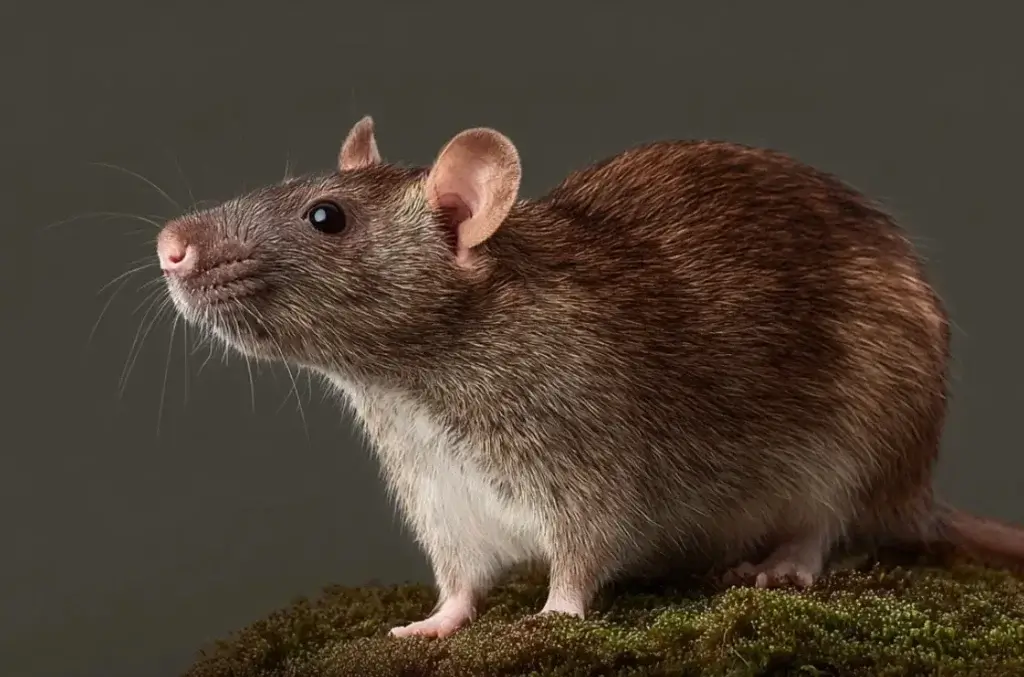
Norway Rats
Norway rats (Rattus norvegicus), often referred to as brown rats, are among the most widespread and destructive rodent species globally. Known for their adaptability, strong survival instincts, and reproductive capacity, these rats thrive in close proximity to human habitations.
At A-1 Pest Control, our team of seasoned pest professionals is trained to identify, manage, and eliminate Norway rats effectively using humane, science-based strategies. Whether you're dealing with signs of infestation or want to prevent one, we’re here to help.
Table of Contents
What Are Norway Rats?
Norway rats are sometimes confused with other rodents like the black rat (also called the roof rat), but they can be usually be distinguished by their bulkier frame, shorter tails, and blunter noses. These rodents are also commonly referred to as sewer rats, wharf rats, brown rats, Hanover rats, or house rats.
Why Are They Called Norway Rats?

The term "Norway rat" stems from a historical misidentification. Early taxonomists mistakenly believed these rodents arrived in England on Norwegian ships, leading to the misleading moniker. Today, their scientific name, Rattus norvegicus, reflects this origin story—despite the fact that their lineage likely began in central Asia.
Despite the inaccurate naming, the term has persisted, and “Norwegian rat: or "Norway rat" are now widely recognized in pest control and scientific communities alike.
Physical Characteristics of Norway Rats
Size and weight
- Large and muscular compared to other rats
- Adults typically weigh 12–16 ounces, though some well-fed specimens can reach 20 ounces
- Body length ranges from 10 to 12 inches, with tails that are slightly shorter than the body
Fur and coloration
- Coarse fur, usually brown with scattered black hairs
- Undersides are lighter, ranging from gray to white
- Urban Norway rats are often darker gray due to environmental conditions
Physical features
- Small ears and eyes, unlike those of roof rats
- Blunt snout
- Poor eyesight; they rely heavily on touch and smell to navigate
Behavior and habitat
- Primarily ground-dwelling, unlike black rats which prefer climbing
- Roof rats infest attics and high spaces, while Norway rats burrow along foundations and under debris
- Sometimes referred to as wharf rats when living near water, as they adapt easily to maritime environments but remain the same species
Behavior and Ecology
Activity and diet
- Primarily nocturnal, emerging at night to search for food and water
- Omnivorous diet, including grains, meats, vegetables, and discarded human food
- Food intake depends on environmental availability; urban areas often provide a consistent and plentiful supply
Burrowing and nesting
- Known for excavating extensive burrow systems
- Prefer nesting in soil near buildings, under woodpiles, or inside basements and crawl spaces
- Burrows often have multiple entry and exit points, forming complex tunnel networks
Foraging and social behavior
- Exhibit advanced foraging behavior, cautious and quick to learn, making improperly placed traps less effective
- Colonies are structured hierarchically, with dominant males and multiple females
- Social groups show high levels of cooperation, including grooming, nest sharing, and protective behavior
Reproduction and care of young
- Young remain in nests for several weeks
- Female rats care for the young, tending to their development and safety
Predators
- Natural predators include dogs, coyotes, and birds of prey
- Domestic cats frequently prey on Norway rats
Reproduction and Rat Populations
Norway rats are prolific breeders. A single female rat can produce up to seven litters per year, with each litter containing 6 to 12 pups. This leads to explosive growth in rat populations, especially in areas where food and shelter are readily available.

Female rats reach sexual maturity in just five weeks, and their gestation period lasts about three weeks. Within days of giving birth, breeding wild brown rats can start reproducing again, a phenomenon that helps sustain dense wild populations. Wild brown rats are especially successful in urban environments due to their adaptability and breeding efficiency.
Spread, Habitat, and Invasiveness
As an invasive species, Norway rats have colonized nearly every continent except Antarctica. They are especially common in urban areas and along coastlines, where human habitations provide easy access to shelter and nourishment.
These rats lower biodiversity by competing with native species for food and space. Their nesting habits can cause major infrastructure damage, and their presence in urban areas increases the risk of infectious diseases. In North America, they are now the dominant rat species in most metropolitan areas.
Health Risks and Diseases Associated with Norway Rats
Disease Transmission
Norway rats are vectors for a broad range of serious illnesses. Infected brown rats may carry rat bite fever, salmonella, leptospirosis, and in extreme cases, bubonic plague. These diseases can be transmitted through bites, contaminated surfaces, or contact with feces and urine.
Contamination and Public Health Threats
Norway rats frequently contaminate food and surfaces with droppings and urine. Their proximity to human food and water systems makes them dangerous inhabitants of any structure.
This contamination is a major concern for restaurants, homes, and commercial properties. The presence of even a few remaining rats after an initial infestation poses long-term health risks.
Identifying a Norway Rat Infestation
Recognizing the signs of a rat infestation early is essential. Here’s how to spot the indicators of their presence and take action:
Droppings Around Baseboards, Under Sinks, and Near Food
One of the earliest and most visible signs of a norway rat infestation is the presence of droppings. These droppings are capsule-shaped, dark, and about ¾ inch long.
You’ll often find them clustered in areas where rats are most active—especially along baseboards, in kitchen cabinets, under sinks, and anywhere food is stored. Fresh droppings are moist and dark, while older ones appear dry and lighter in color.
Gnaw Marks on Wood, Plastic, and Wiring
Rats have strong teeth that never stop growing, which is why they constantly gnaw on objects to keep them trimmed. Norway rats frequently chew through wood, plastic containers, cardboard boxes, and even electrical wiring, which can pose fire hazards.
If you find gnaw marks—especially near food storage or structural entry points—it’s a clear indication of rat activity.
Burrow Holes Outside, Near Foundations or Sheds
Norway rats are skilled diggers and will excavate extensive burrow systems outdoors. Look for entrance holes 2–4 inches in diameter near the foundation of your home, along garden edges, under decks, or near outbuildings like sheds.
Active burrows may have smooth, worn edges and paths leading to them. These underground networks often house entire rat colonies.
Scratching or Scurrying Noises, Especially at Night
Because norway rats are primarily nocturnal, you’re most likely to hear them at night. Listen for scratching, rustling, or scurrying sounds in walls, ceilings, or under floors.
These noises are a common indicator that rats are actively nesting or moving about within your home. The sounds may grow louder as the infestation expands.
Greasy Rub Marks Along Walls and Floorboards
Rats often travel the same paths repeatedly, leaving behind grease and dirt from their fur. Over time, these repeated movements create smudge marks along walls, baseboards, and around entry points.
If you see dirty or greasy streaks in low or hidden areas, it’s a strong sign of consistent rat traffic.
Sightings of Large Brown or Dark Grey Rats
Actually seeing a rat during the day is the most obvious sign of a serious infestation. Norway rats are typically shy and avoid daylight. However, when populations grow too large or food becomes scarce, they are forced to forage during the day. Sightings of large brown or dark grey rats—especially in or around kitchens, basements, or trash areas—suggest a high-density rat population.
Comparing these signs can help you determine whether you’re dealing with norway rats, black rats, or roof rats. Norway rats typically stay low to the ground and prefer burrowing, while black rats and roof rats are more likely to climb and infest upper areas like attics.
Proper identification is essential for developing an effective rat control strategy.
How to Get Rid of Norway Rats
Step 1: Inspection and Assessment
A professional inspection determines the scope of infestation, entry points, and nesting locations. This is the foundation of any successful rat control plan.
Step 2: Sanitation and Exclusion
Eliminating food sources—like discarded human food—is essential. Secure trash cans, seal food storage areas, and remove clutter. Entry points should be sealed with materials that rats cannot chew through.
Step 3: Trapping and Removal
Snap traps and bait stations are the most effective tools. A combination of traps helps ensure both dominant and cautious rats are caught. Professionals understand the behavioral patterns that influence trap placement and effectiveness.
Step 4: Ongoing Monitoring and Prevention
Following removal, ongoing monitoring is essential to ensure that remaining rats don’t reestablish colonies. A-1 Pest Control offers long-term pest control plans to ensure your home or business stays rodent-free.
Frequently Asked Questions
How do you identify a Norway rat?
Look for a large, heavy-bodied rat with a blunt nose, small ears, and a tail shorter than the body. Their fur is typically brown or dark grey, and their droppings are capsule-shaped.
Why are they called Norway rats?
The name comes from a mistaken belief that the rats arrived in England from Norway. The term stuck, though their true origin is likely Asia.
How do you get rid of Norway rats?
A combination of sanitation, exclusion, trapping, and professional pest control services is the most effective way to eliminate them.

